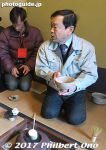 Image search results - "match" Image search results - "match" |

Jishu Shrine is also within the Kiyomizu-dera grounds. This shrine is dedicated to love matches and marriage. The statue is Okuninushi-no-Mikoto, god of love matchmaking.
|
|

Jishu Jinja Shrine 地主神社
|
|

We noticed mostly young women and girls were praying at this shrine. Very few guys.
|
|
|
|
|
|

Talisman for good love matches
|
|

One love stone. If you can walk from this stone to the other one blindfolded, you will find love by yourself.
|
|

The other love stone.
|
|

The woman reached the other stone and will find love.
|
|
|

As part of the annual Nagahama Shusse Matsuri festival held on the second Sat. of Oct., a matchlock gun demonstration (長浜火縄銃大会) is held at Nagahama Castle during 13:30 a.m.–12 p.m. Nagahama Castle is near JR Nagahama Station (West side) on the Hokuriku Line. Short ride from JR Maibara Station.
|
|

Three matchlock gun battalions to shoot their guns (blanks of course). The battalions are from Tanegashima (Kagoshima), Sakai (Osaka), and Hikone (Shiga). Japan has a number of matchlock gun battalions who are licensed to possess and fire these guns to preserve their history and perform at events and festivals.
|
|
|
|

This battalion was from Tanegashima island in Kagoshima Prefecture (Kyushu). That's where guns were first introduced to Japan from Europe in 1543 and forever changed warfare in Japan.
|
|

Taking aim and ready to fire...
|
|

BANG!!! The guns were extremely loud. Makes you jump.
|
|

They were going to take turns and keep shooting for about 90 min. I can handle these loud bangs once or twice, but no more. So I left this event early right after seeing/hearing/photographing this first battalion fire their guns. I didn't want to risk any damage to my ear drums. I wonder how these gunners protect their hearing.
|
|

Chotaro Horii is the 6th-generation owner/operator of Horii Shichimeien which was originally Okunoyama Chaen (奥ノ山茶園), one of Uji's Seven Reknown Tea Fields (七名園).
|
|

In 15th century, Ashikaga Yoshimitsu and Yoshinaga loved Uji tea so much that they designated seven tea fields as the Seven Reknown Tea Fields. Today only Okunoyama Chaen remains.
|
|

Only part of the original Okunoyama Chaen remains as a tea field. The original Okunoyama tea field was larger. Notice the shade.
|
|
|
|

Near their tea farm, Horii Shichimeien also has a tea shop selling some of Japan's finest tea.
|
|
|

Some of the finest Uji matcha powder at Horii Shichimeien.
|
|

Some of the finest Uji matcha powder at Horii Shichimeien.
|
|

Behind Horii Shichimeien's tea shop is a small tea house for tea ceremony. Mr. Horii kindly prepares his finest marcha tea for us.
|
|
|

Matcha tea and a confection. The tea was outstanding. It had a malty, matcha taste. Pretty thick. The aftertaste was interesting.
|
|
|

Mrs. Horii prepares a different kind of tea.
|
|

We then got to see Horii Shichimeien's matcha tea factory. (Note that this is not open to normal tourists.)
|
|

Inside Horii Shichimeien's tea factory.
|
|

It was a room full of stone grinders grinding matcha tea leaves into fine matcha power.
|
|

Stone grinders grinding matcha (tencha) tea leaves into fine matcha power at Horii Shichimeien's tea factory.
|
|

Stone grinders grinding matcha tea leaves into fine matcha power at Horii Shichimeien's tea factory. Watching these grinders was mesmerizing..
|
|

Matcha tea leaves to be ground.
|
|

Sample grinder. The dried tea leaves are fed through a funnel to the grinding stones.
|
|

Grinder face
|
|

Small grinder.
|
|

Tourists visiting Byodo-in temple can also experience and taste Uji tea at nearby Takumi no Yakata (匠の館).
|
|

Entrance to Takumi no Yakata (匠の館).
|
|
|
|











































